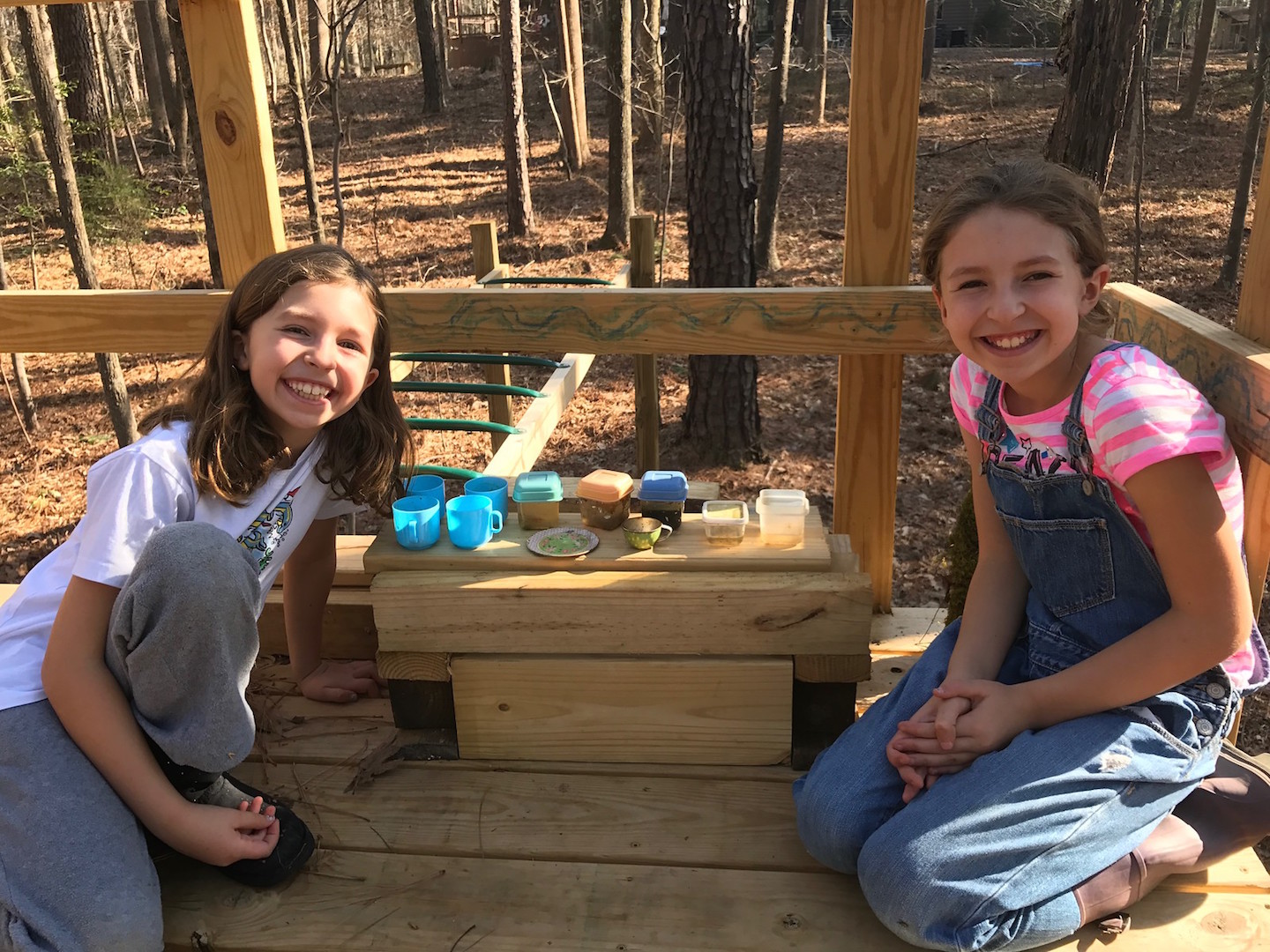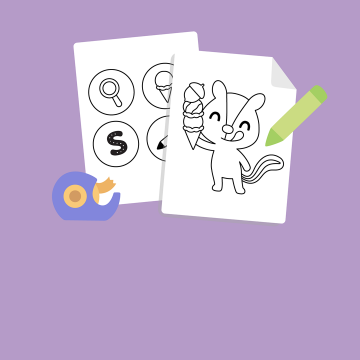- Let Them Be Kids: A chat with Connie Bossert, educational psychology specialist and app developer

From her former career as a professor of Educational Psychology to her current role as CEO of , Connie Bossert has made a career of studying, and putting into practice, play-based learning – both professionally and at home with her two daughters. Connie kindly made some time to chat with us about how she facilitates open-ended play in her family, the benefits of screen time and how children can often be the most discerning customers of all.
Tell us a bit about your journey from college professor to kids’ app creator! Why the switch into kids’ tech?
I was teaching educational psychology and child development classes at NC State University when I got my first smart phone in 2009. When I saw my 3-year-old daughter easily browse through photos on it, I realized that touch screen devices have tremendous potential for children’s interactive media. My husband and I had developed a few casual games for the iPhone, and we decided to develop a counting game for preschoolers. After developing several more games, we decided to focus the brand of our company exclusively on educational apps and games for children. In these past ten years I’ve had the privilege of working with some of the top names in the business as a consultant, designer, developer, and illustrator. It’s been such a rewarding experience to make a positive impact on the changing landscape of kids’ tech.
From an educational psychology perspective, why is learning through play so vital for children’s development?
Play is what children do naturally. When kids play, they become absorbed in their game… they are focused and engaged in the activity, they often participate in dialogue with others, they are motivated to continue the game, and the experience is meaningful to them. As it turns out, these qualities - active engagement, social dialogue, motivation, and meaningful context – are the very things that are catalysts for learning. Educators and parents can take advantage of these catalysts by creating an environment for purposeful play experiences.
What does play-based learning look like?
In a classroom, a play-based learning approach usually features centers in which children can play with various materials related to art, building/engineering, science, literacy, numeracy, problem solving, or technology. Often, each area is themed with a real-world context, e.g. “kitchen”, “library”, “construction zone”, “theater”, “veterinarian”.
An outdoor “nature kitchen” is another good example of a play-based learning environment. It might include measuring cups and spoons, cups, plates, bowls, spice jars, and utensils for cooking. Perhaps there is a chalkboard for writing recipes or a menu. There may be natural materials such as water, sand, sawdust, stones, and seeds for children to use as ingredients to make foods.
One of the things I like about a play-based learning approach is that it meets each child at his or her level and learning style. Different children can interact with the materials according to their own abilities, interests, and prior knowledge. They can also work together to solve problems or learn from a more advanced child.

Connie's daughters in their 'open-ended play' treehouse!
How have you seen the benefits of play-based learning in your own children?
Play-based learning is a natural fit for our family. My children easily slip into pretend mode and everything becomes part of an imaginary story or game. When that happens, they become focused and motivated to achieve the outcomes of the fantastic story they have created. I have seen them use engineering skills to build something, or use trial and error to solve a problem. Sometimes they may role-play to work out social problems. On other occasions they might use creativity to set the scene for a game. There are times when they practice reading, writing, communication, and negotiation skills. They also emulate adult jobs, responsibilities, and actions as they play out the scripts of their imagination. I encourage and support play-based learning because I can see that my kids are benefiting from it.
If you could give one piece of advice to another parent who’s looking to incorporate more play-based learning into their lives, what would it be?
In my experience, there are two main parts of incorporating play-based learning with your children: First, let them be kids. Second, support the learning.
Let them be kids. In your busy life filled with school and organized activities and family commitments, make sure there is time for messy, unstructured play. During this time, your kids will naturally begin to use imagination to create and build and solve and pretend. They will become knights, dragons, chefs, princesses, warriors, or animals.
Support the learning. You can support the learning by providing props, materials, assistance, and suggestions to help their play come to life. For example, if your children are pretending to be firefighters, provide a cardboard box to use as a truck. When the kids are playing restaurant, give them paper and crayons to create menus. If they are building a stick fort, teach them to use some garden tools. When they are chefs, help them use measuring cups, spoons, and bowls. Ask questions and let them work out the answers. Join in the fun by becoming a pretend customer or student or neighbor.
Here's a quick personal example of the “Let them be kids - Support the learning” approach:
One time a few years ago I asked my kids to deliver some eggs to my Mom, who lives next door. My oldest daughter jumped up and stood at attention, announcing “Triple-A Delivery Service, ready for action!”. I gave her the eggs and she marched out the door, with little sister marching behind.
Soon they returned and announced, “Special delivery for Mommy Bossert!”. They handed me a note that said, “Love the new delivery service. Here is the bowl I borrowed yesterday. - Mom”. I got out some stationery and packing paper, and soon the Triple A delivery service was bringing envelopes and packages to every family member (and pet!) in each household. I took the opportunity to show my girls how to format a letter, properly address an envelope, and apply a stamp. They learned that a stamp shows that the cost of delivery has been paid for. They learned the fundamentals of how a delivery business would work. They practiced their writing skills. And for them, it was a fun afternoon of play and pretend that included the whole family. Now, years later, they still ask if we can play the delivery service game!
What are your thoughts on screen time? Any tips on how parents can balance the drawbacks with the benefits?
I think it’s important for parents to realize that not all screen time is the same. Watching a cartoon, browsing online videos, playing a game, and practicing math skills can all happen on-screen, but each experience is completely different. As a result, managing screen time and a healthy life balance is not as simple as restricting usage time.
I have found that managing screen time is very similar to managing your child’s diet. In the beginning, you choose a healthy diet for your children that includes a variety of foods that will help them grow. You model a healthy diet by eating your own vegetables. Then you teach your children about healthy choices so that they will begin to monitor their own diet. Similarly, you can introduce screen time with a selection of apps and games that promote healthy play, creativity, problem solving, and life skills learning. You can model healthy screen habits by using your device for useful purposes such as looking up information. You can teach your children about maintaining a healthy life balance by teaching them to choose on-screen activities that are worthwhile and making sure that on-screen activities do not replace real-life experiences.
What has playtesting your apps taught you about how kids learn through play, and through tech?
I have learned not to underestimate our children. Not only are they very tech-savvy, they are also discerning customers who have a very keen sense of quality. They can sense when a developer has taken a fun game and tacked-on ABC’s to make it educational, or when a developer has attempted to turn 123’s into a “fun game”. Kids crave (and deserve!) a rich experience in which they can practice real life skills in a meaningful context. When we play-test our apps, we watch the kids’ faces. If they are smiling and laughing and intently engaged, then we know we’re hitting the mark.

Connie with her two daughters.
Read more from Connie at


